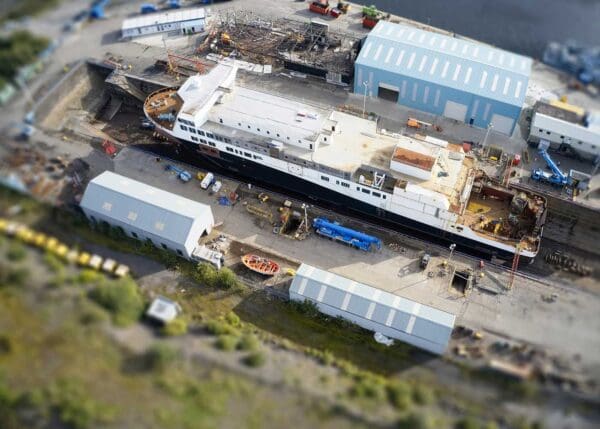01. Shipyard History
History
Key Highway Shipyard was founded by boatbuilding brothers William Skinner Jr. and Jeremiah Skinner in the 1820s. Located on the southern side of the Inner Harbor in Baltimore, Maryland, the shipyard operated from the 1820s until 1982.
During the Civil War, the shipyard focused on building sailing vessels. Work at Key Highway Shipyard continued with construction of several different types of ships including barks, schooners and bay steamers.
Bethlehem Steel Company took over ownership of the shipyard in 1921. As such, the shipyard is sometimes referred to as part of the Bethlehem Baltimore shipyards owned by Bethlehem Steel.
Key Highway Shipyard eventually became a repair facility. In fact, during World War II (WWII), the shipyard repaired more than 2,500 ships and employed 11,000 workers. Asbestos products were frequently used in shipbuilding during WWII.
In the 1950s, the shipyard began the process of “jumboizing” or “jumbo sizing” ships. This process cut the mid-body of the ship and added a larger midsection to increase cargo space. Cutting and sawing asbestos-containing materials may have created an exposure risk for workers nearby.
The shipyard closed in 1982 and all operations were transferred over to Sparrows Point Shipyard. Today, the shipyard has been replaced with the Ritz Carlton and HarborView Communities.
Key Highway Shipyard History at a Glance
- Other Names: Bethlehem Baltimore Shipyards, Bethlehem’s Key Highway Yard, Bethlehem Steel Key Highway Shipyard, Key Highway Yards, Skinner Shipyard, Upper Yard, William Skinner and Sons Shipbuilding and Drydock Company
- Location: The southern side of the Inner Harbor in Baltimore, Maryland
- Owner(s): Bethlehem Shipbuilding Corporation, Bethlehem Steel Company, the Skinner Family
- Years of Operation: 1820s – 1982
- Wartime Operations: Civil War, World War I (WWI), World War II (WWII)
- Number of Employees: 11,000 during WWII
- Size of Shipyard: 35 acres
- Noteworthy Ships: Steam Tug Baltimore, USS Avenge, USS Bellona, USS Diamond Head, USS Indra
- Noteworthy Personnel: Captain William Turnbull Burwell, Lt. Ambrose Wyckoff
- Types of Ships Built/Serviced: Ammunition ships, barks, bay steamers, landing craft repair ships, schooners
Many workers at Key Highway Shipyard were potentially exposed to asbestos. Workers’ loved ones may have also experienced secondhand exposure. As a result, many people developed asbestos-related diseases, such as pleural mesothelioma, peritoneal mesothelioma, asbestos lung cancer and asbestosis. People who developed an asbestos-related disease may be eligible for compensation.
Notable Ships Built and Repaired
Beginning in the 1920s, work at Key Highway Shipyard commonly consisted of ship repairs and conversions. Two notable ships converted here in the 1940s were the USS Bellona and USS Diamond Head.
USS Bellona
In 1944, the landing craft repair ship, USS Bellona, was laid down (construction began) at Chicago Bridge and Iron Company in Illinois. She was then moved to Key Highway Shipyard for conversion to its ship type. The USS Bellona served in WWII as a part of the Pacific Fleet in Iwo Jima, but lost grounding and was declared unsalvageable. She was destroyed in 1946.
Asbestos was heavily used in shipbuilding and conversions in the 1940s. Workers who came in contact with the USS Bellona at Chicago Bridge and Iron Company and Key Highway Shipyard may have experienced exposure from asbestos products on board. Crew members who served on the USS Bellona may also risk developing mesothelioma.
USS Diamond Head
The USS Diamond Head was an ammunition ship constructed at North Carolina Shipbuilding Company in North Carolina. After the ship was laid down, she was sent to Key Highway Shipyard for conversion. The USS Diamond Head was decommissioned in 1946 and became part of the Atlantic Reserve Fleet in Galveston, Texas.
The USS Diamond Head was recommissioned in 1951 and served in the Vietnam War, earning three campaign stars. In 1974, the ship was sold for scrap.
From the time the ship was constructed to the time she was scrapped, asbestos was used on the USS Diamond Head. Anyone who worked or served on her may be at risk of developing asbestos-related diseases.
02. Shipyard Asbestos Use
Asbestos Use at Key Highway Shipyard
Asbestos is highly heat resistant and durable. So asbestos was used in many aspects of ship construction. Shipbuilders used it to prevent fires and control the amount of heat released by heavy equipment.
Key Highway Shipyard was very active during WWI and WWII. During this time, asbestos use was very common. At Key Highway Shipyard, asbestos was used as insulation in walls, boilers, incinerators and around pipes. As a result, workers came in contact with many products that put them at risk of asbestos-related diseases.
Asbestos Exposure at Key Highway Shipyard
Members of the U.S. military and civilians provided labor in shipyards and on ships. Asbestos was used in most shipyards, including Key Highway Shipyard and other Bethlehem Baltimore shipyards, and aboard most vessels from the 1930s to the 1980s. This likely exposure puts Navy veterans at an increased risk of malignant mesothelioma cancer.
People who constructed or maintained bay steamers, landing craft repair ships and ammunition ships during this time were likely exposed to asbestos. These people often worked in space-constrained and poorly ventilated areas, which possibly allowed more asbestos fibers to remain in the work areas.
Starting in the 1980s, most newly manufactured products did not contain asbestos. However, anyone who continued working in the shipping industry risked exposure to asbestos. That exposure could occur through existing, or legacy, asbestos materials. Many shipyard duties, including insulating the ship, maintaining boilers and installing pipes, exposed people to asbestos.
03. Asbestos Lawsuits
Asbestos Lawsuits and Settlements
Anyone who spent time at Key Highway Shipyard and developed asbestos cancer or another asbestos-related disease has potential compensation options. The companies who manufactured the products that exposed these people to asbestos may be held responsible.
How an individual can be compensated depends on the status of the responsible asbestos company. A mesothelioma lawyer can help the victim secure compensation through a lawsuit, VA claim or trust fund claim (or a combination of these options).
Holding Asbestos Companies Responsible
Some asbestos companies are still operational and have not filed for bankruptcy. Individuals can still file mesothelioma lawsuits against such companies. Asbestos lawsuits may result in verdicts or settlements.
For example, people were wrongfully exposed to asbestos because of pumps supplied by FMC Corporation that included packing or gaskets containing asbestos. These pumps put pipefitters, steamfitters, mechanical engineers and other workers at risk of developing asbestos-related diseases such as mesothelioma.
Another viable pump supplier, Buffalo Pumps Inc., put workers and crew members at risk of asbestos exposure through their products. The pumps were regularly supplied to ships and shipyards during WWII, putting thousands at risk of asbestos exposure over the years.
Some victims have filed successful lawsuits against these companies.
04. Filing Asbestos Claims
Asbestos Company Trusts
Since the 2000s, more than 100 companies have filed bankruptcy after exposing people to asbestos and facing lawsuits that followed. Many of these asbestos companies had to create asbestos trust funds to compensate current and future victims of asbestos-related diseases.
Asbestos was a common occupational hazard for shipyard workers. If a shipyard worker has developed an asbestos-related disease, a lawyer can help that person file a claim against the applicable manufacturer’s trust.
Asbestos Company Trust Funds and Eligible Years of Employment
The following companies were some of the asbestos product suppliers to Key Highway Shipyard. After facing many asbestos lawsuits and exposing innocent people to asbestos, these companies filed for bankruptcy and created trusts to pay victims. If an individual worked at Key Highway Shipyard and developed a disease such as mesothelioma, they may be able to file mesothelioma claims against these companies’ trusts.
| Asbestos Trust Funds & Eligible Years of Employment | ||
|---|---|---|
| Asbestos Company Name | Eligibility Start Date | Eligibility End Date |
| ACandS Inc. | 1/13/1964 | 12/31/1982 |
| Armstrong WI Trust | 1/1/1955 | 12/31/1982 |
| Babcock and Wilcox | 1/1/1930 | 12/31/1982 |
| Fibreboard | 1/1/1954 | 12/31/1982 |
| GI Holdings (GAF) | 8/18/1971 | 12/31/1982 |
| Harbison Walker | 8/30/1965 | 10/17/1974 |
| Owens Corning | 1/1/1953 | 12/31/1982 |
| Porter Hayden | 1/1/1934 | 12/31/1982 |
| United States Gypsum | 1/1/1937 | 12/31/1982 |




